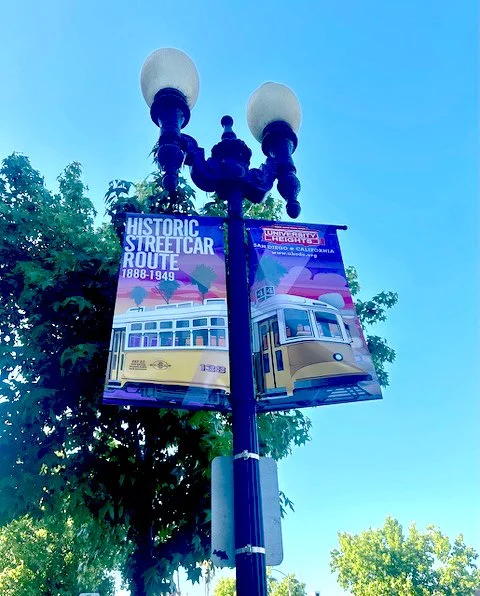New UH Trolley Banners Celebrate Our Transit History
With the installation of the new trolley banners on Park Boulevard and Adams Avenue by the University Heights Community Development Corporation, this is a good time to reflect on the importance of the trolley lines in the early development of University Heights.
As John D. Spreckels, founder of the San Diego Electric Railway in 1891 once said, “Before you can hope to get people to live anywhere ... you must first of all show them that they can get there quickly, comfortably, and above all, cheaply. Transportation determines the flow of population.
Transportation was key to the early development of University Heights. After the final link between San Diego and the transcontinental railroad was completed in 1885, several speculative real estate developments were begun in San Diego including University Heights. On August 6, 1888, Subdivision map #558 was filed with the San Diego County Recorder, delineating the new University Heights subdivision.
As streets were graded, water and sewer lines established, and lots offered for sale in University Heights, the Electric Rapid Transit (ERT) extended its electrified cable car in 1888 from downtown San Diego up Fourth Street to University Avenue (then Normal Street) and then up Park Boulevard to University Heights.
However, the ERT experienced difficulties right from the start including frequent shutdowns, various alterations and repairs, an oil shortage, and legal battles. Consequently, by 1889 the line closed.
That year, the San Diego Cable Railway Company organized using leftover assets from the ERT and developed a five-acre park in 1890 called The Bluffs at the end of the rail line at Park Boulevard and Adams Avenue to increase ridership. However, due to a series of financial setbacks, the Cable Railway Company was also forced to shut down in 1891 after just 13 months of operation.
The Cable Railway Company was bought by George Kerper in 1895, who reorganized it into the Citizens Traction Company. Kerper electrified the rail line and renamed The Bluffs park as Mission Cliff Park. Unfortunately, the Citizens Traction Company also went into receivership in 1898 during the height of a nationwide depression.
In the late 1880s, John D. Spreckels, son of wealthy “Sugar King” Claus Spreckels, began investing in San Diego’s infrastructure. In 1891, he formed the San Diego Electric Railway (SDERY) and began buying and consolidating several of San Diego’s failed or failing transportation lines.
By 1910, the SDERY was the only remaining trolley operator in San Diego, covering more than 165 miles of track from La Jolla to Chula Vista. The new railway routes extended into barren scrubland and paved the way for new neighborhoods including University Heights, North Park, Hillcrest, and Mission Hills.
After purchasing the Citizens Traction Company in 1898, the SDERY renamed Mission Cliff Park as Mission Cliff Gardens. The park encompassed some 40 acres at its height in 1914.
In 1910, the City of San Diego announced that the Panama-California Exposition would be held in Balboa Park in 1915. This caused a large-scale increase in home, hotel, and apartment construction throughout the city—including University Heights—and the streetcar line along Park Boulevard was extended to Balboa Park. In 1913, the San Diego Electric Railway built a massive trolley car barn on Adams Avenue at Florida Street. The cavernous reinforced-concrete building was used to store and service several hundred trolleys that entered and exited the car barn through a series of switches off Florida Street.
By the 1930s, streetcars were losing business to city buses and private automobiles. In 1948, Jesse L. Haugh purchased the San Diego Electric Railway Company from the Spreckels interests and changed the name to San Diego Transit System. San Diego became the first major California city to convert to an all-bus transit system. And so on April 24, 1949, at 5:35 a.m., the most senior operator at San Diego Transit, N.A. Holmquist, drove car #446 into the Adams Avenue trolley car barn, ending rail transit in San Diego.

